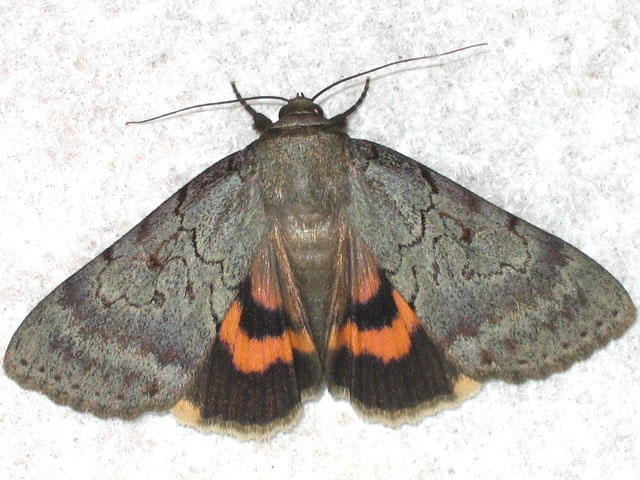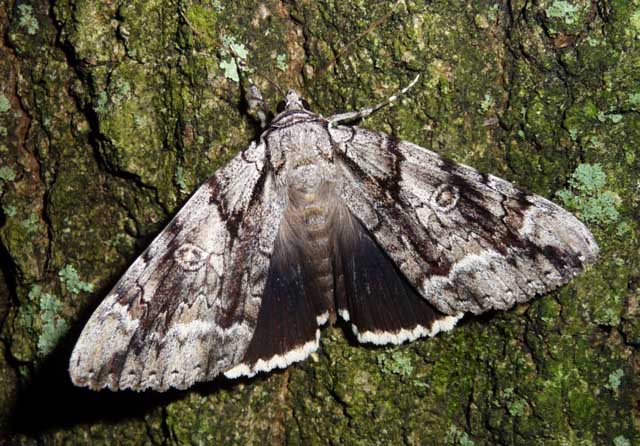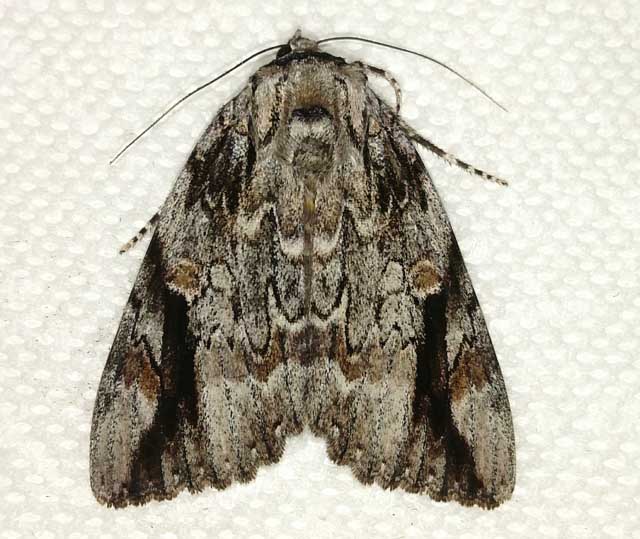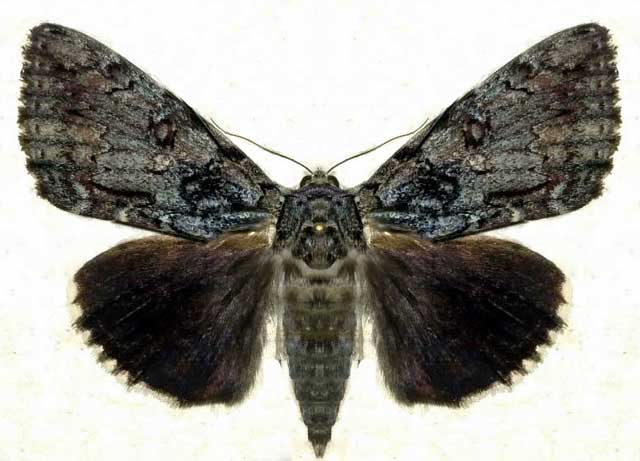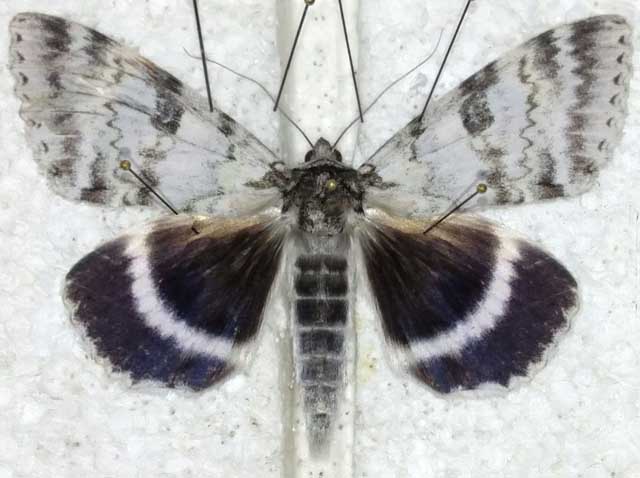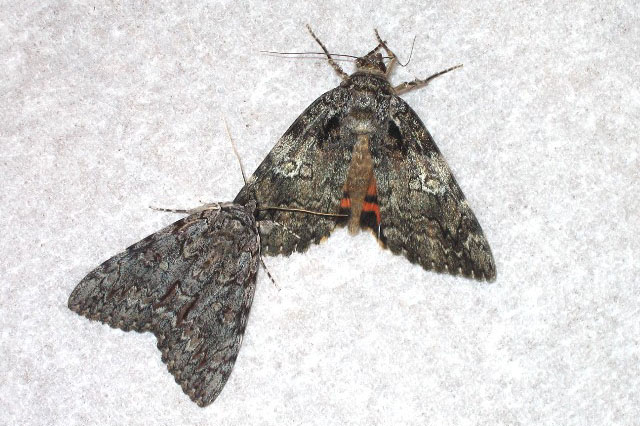
| **8878 Catocala amica;
Girlfriend; wingspan: 35-40mm
The black postmedian band is absent from the dorsal (upper)
surface of the hindwing, but it is present on the ventral surface.
Moths come in to lights and to bait.
Catocala amica lineella is now (2010) elevated to full species status as Catocala lineella.
Maurice Bottos image.
|

| ** 8878.1 lineella;
Little Lined Underwing; wingspan: 35-40mm.
This species is without hw marginal black band. Fw subreniform spot is pale and boldy
outlined with black. There is similar light brownish-gray patch in
upper half of median area near pm line, and just between
subreniform spot and am line there is similarly
coloured light patch paralleling am lne.
The reniform spot is dark, less distinct and in a generally darker
area.
|

| Catocala jair;
35-40mm. The moth is hard to distinguish from amica, but jair has broader, blunter forewings than amica and the post medial
line of jair is straighter (much less dentate) than that of amica. The hindwings of both species seem identical.
|

| ** 8874 Catocala minuta TM;
Little Underwing, 35-45mm;
Fw grey-brown, greatly widened, white, st line
(near costa only).
Hw outer black band unbroken, inner band
in complete loop, brown scaling along
im.
"eureka" Schwarz: blackish area between am,pm lines;
"hiseri" Cassino: dull grey fw, very faint markings;
"mellitula" Hulst: blackish patch in basal area from costa to
im;
"obliterata" Schwarz: melanic form, almost completely
black fw;
"parvula" W. H. Edwards: broad dark patch along fw i. m..
|

| ** 8846 sordida;
Sordid Underwing, wingspan: 37-45mm:
Fw is lighter along costa and darker along inner
margin. Dark medial lines are especially evident through lighter
shades near costa. Outer black band of the hindwing is broken
near the anal angle.
I made the determination on the moth to the left based on
dark scaling along the inner margin limited to median area
and submarginal "teeth" relatively
short and blunt. Tim Dyson image.
|

| ** 8873 similis;
Similar Underwing, wingspan: 35-45mm.
Pale triangular patch from pm line along costa,
pointed at apex, light-coloured, tear-shaped reniform
spot. Subreniform
spot projects much beyond
reniform anteriorally at right angle to subreniform line.
Many specimens have small, light coloured, flattened oval spot
about halfway between pm/ am lines near midpoint of
reniform spot. Pm line almost straight for most of
length.
|

| ** 8877 connubialis,
Connubial Underwing, (wingspan: 35-50mm).
Fw highly variable; several different
forms: "sancta" Hulst: forewings with
white ground colour and sharply contrasting black lines and markings.
Brown shading between pm and subterminal
lines; "cordelia" H. Edwards: as above but markings are
faint; "pulverulenta" Brower: grey-green forewings with faint
markings, sometimes none;
"broweri" Muller: melanic form with forewings dark
green, almost black.
Hw has separate anal spot and outer band ends with
straight cut.
Leroy Simon image.
|

| ** 8848 louiseae,
Louise's Underwing, (wingspan: 40mm).
There is a distinct white "smile" (in spread specimens) between the reniform and subreniform spots.
There is also a narrow but distinct white line immediately following the black postmedial line.
Hw deep yellow orange, outer black band interrupted,
followed by dot, ending before im.
|

| ** 8772 gracilis;
Graceful Underwing, wingspan 40-45mm.
Gracilis closely resembles sordida but the hindwing loop is not complete in gracilis as it is in sordida. Gracilis also tends to have a darker
inner margin and there is frequently (99% of the time, Dale Schweitzer, via Joe Garris), but not always, a basal dash. Sordida never has the basal dash.
|

| ** 8864 Catocala grynea ; Woody Underwing, 40-50mm.
Fw dull greenish grey with orangey-brown shading along
the inner margin. Antemedial, median and pm lines are
quite faint.
Praeclara somewhat similar but has break in brown shading
between am and pm lines. Praeclara also has a paler orange
hindwing color.
Tim Dyson image. |

| Catocala pretiosa
Precious Underwing; 40-50mm;
This species is quite similar to crataegi and mira, but pretiosa has considerable creamy white colouration in the median area. The lower
portion of the basal area is also light, not dark as in crataegi.
The inner black band of the hindwing forms a loop and the outer band is broken (not complete as in mira, followed by a dot that tapers to the anal angle.
|

| ** 8865
praeclara; Praeclara Underwing, (40-50mm);
The forewing is a pale greenish-grey with considerable contrasting
brown shading beyond post medial line.
There is a black basal dash very close to the inner margin and
another dash, higher up in the median area.
Note the contrasting shapes of the reniform and subreniform spots.
Tim Dyson image. |

| ** 8876 Catocala micronympha
form gisela,
the Little Nymph Underwing, (wingspan: 35-50mm).
The usual specimens have grey forewings shaded with green, brown,
black and white tints. There is usually a darkened band passing from
the costa through the reniform spot to the outer margin.
Form "gisela" Meyer has a forewing that is mostly black.
Leroy Simon image.
|

| ** 8876 Catocala micronympha
form hero,
the Little Nymph Underwing, (wingspan: 35-50mm).
The usual specimens have grey forewings shaded with green, brown,
black and white tints. There is usually a darkened band passing from
the costa through the reniform spot to the outer margin.
Form "hero" H. Edwards has a median area that is mostly white.
Joe Garris image.
|

| ** 8876 Catocala micronympha
form lolita,
the Little Nymph Underwing, (wingspan: 35-50mm).
Form "lolita" Sargent has very dark forewings.
Harold J. Vermes image, used with permission from his son.
|

| ** 8876 Catocala micronympha
form sargenti,
the Little Nymph Underwing, (wingspan: 35-50mm).
Usual specimens have grey forewings shaded with green, brown,
black and white tints. Usually a darkened band passing from
costa through reniform spot to outer margin.
Form "sargenti" Covell (very rare) has a hindwing that is all black.
|

| ** 8867 Catocala blandula;
Charming Underwing, wingspan: 40-50mm.
Pale basal area of fw distinguishes mira from
blandula (dark brown) and crataegi (black).
Fw has dark contrasting lines as in crataegi.
There is also considerable brown in subterminal area
and subreniform spot is very conspicuous and usually brown. A
light area runs obliquely from the costa to the subreniform spot.
hw is deep orange and has a complete inner black band.
The outer black band is unbroken.
Lynn Scott image. |

| Catocala mira;
Wonderful Underwing, wingspan: 40-50mm.
Pale basal area of fw distinguishes mira from
blandula (dark brown) and crataegi (black).
Fw lacks dark contrasting lines of crataegi and
blandula. Considerable brown in subterminal area
and subreniform spot very conspicuous, usually brown.
Light area runs obliquely from costa to subreniform spot.
Noticeable space along i. m. between
antemedial and postmedial lines.
Hw deep orange and has a complete inner black band.
The outer black band is unbroken
Tim Dyson image. |

| ** 8858
Catocala crataegi;
Hawthorn Underwing, wingspan: 40-50mm
Determination is based on dark (black) shading in forewing basal
area continuing along inner margin to anal angle and brown shading
beyond postmedial line. Definite greenish cast to
median area.
Lower wing has outer black band, broken near anal angle,
distinguishing crataegi from blandula.
|

| ** 8775
antinympha;
Sweetfern Underwing, wingspan 45-55mm.
Very dark grey, almost black, forewing ground colour
distinguishes antinympha. Some brown shading in
subreniform spot and also just outside postmedial line.
The hindwing is amber to pale orange.
There is also the form multoconspicua Reiff, 1919 with a pale,
almost white subreniform spot.
|
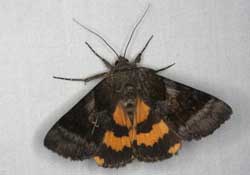
| ** 8776 badia;
Bay Underwing, 50-60mm.
"FW buff-brown, deeper brown in basal area & within pm line;
contrastingly paler beyond pm line; lines faint, barely traceable. HW yellow-orange with black bands; often with terminal yellow-orange line at fringe base.
Specimens from NH may appear transitional to coelebs, having sharp bend of upper part of pm area and more
distinct lines of that species."
|
Solid Black Underwings: Smallest to Largest, Similar Species Paired

|
Catocala andromedae,
Gloomy Underwing, (wingspan: 40-50mm).
Hw: black, dark grey fringe,
coupled with dark i.m. of fws help to identify
this species. Very dark "flying saucer" shape, adjoining
subreniform spot to midpoint of am line.
The "teeth" of pm line short and blunt,
outwardly edged with white. Subterminal line is also outwardly
edged with white.
|

| ** 8781
judith,
Judith's Underwing, (wingspan: 45-55mm),
is one of the smaller "black" underwings. Fw uniform
light grey with thin and only slightly darkened antemedial, median
and postmedial lines. No darkened dashes (slight anal dash)
or transverse lines. Reniform area is slightly darkened while the
area just before the subterminal line is a bit lighter. Note absence of
hw white fringe.
Joe Garris photo.
|
Visit Full size Joe Garris photo.

| ** 8782 Catocala flebilis, yes;
Mournful, wingspan: 54-65mm.
Diffuse black band runs from basal area to
outer margin just below apex, interrupted by pale grey
subreniform spot. Reniform spot is filled with brown; there is
additional brown outside postmedial line. No anal dash
as there is in angusi. The hindwings have white fringe. J. K. Adams
image.
|

| ** 8773
Catocala epione , yes;
Epione Underwing, wingspan: 55-65mm
The pm line is squared and has a brown band and then a light band
just outside the line. The hindwing is black with pure white fringe
with no barring.
John Himmelman image.
|

| ** 8784
obscura;
the Obscure Underwing, (wingspan: 60-72mm),
has dull, grey forewings, usually void of any significant dashes,
streaks, providing for easy identification. Am, median
and pm lines faint and subterminal line
region is only slightly paler than rest of fw.
Hw fringe is off-white, lightly checked on veins.
Joe Garris photo.
|

| Catocala ulalume,
Ulalume Underwing, (wingspan: 65mm).
Fw mottled light to dark grey, no strongly contrasting lines, dashes, bars. Aml ends at im in very light coloured
crescent, close to pml. Open subrenifrom spot light coloured, "comma" shaped with triangular, somewhat bulbous head.
Aml: short, thin, slightly humped dark line through midpoint. Hw black, fringe pure white, thin,
pointed checking.
|

|
Catocala residua;
Residua Underwing, (wingspan: 60-73mm),
distinguished from Catocala obscura by grey hw
fringe of residua.
Catocala obscura has white to off-white fringe and tends to be
less common in northern portions of its range. Fw
subterminal line/area of Catocala residua tends to be pale as
is its open, elongated subreniform spot.
Like C. obscura it is otherwise devoid of significant markings
except for hint of dark bar running from basal area
through reniform spot to o. m. just below apex.
|

|
Catocala retecta;
wingspan: 60-75mm.
Note light coloured, elongated and open subreniform spot
which interrupts dark, diffuse ark running through center of
wing from basal area (body-wing juncture) to fw
apex. Center of reniform spot brown and there is a brown
area just below costa running to inner margin just outside pm
line. Off-white hindwing fringe only lightly checked along
wing veins.
Joe Garris image.
|

| Catocala luctuosa,
Underwing, (wingspan: 70mm).
Fw light grey (yellowish tint) clearly marked with a basal dash that continues with another dash through the
am line, followed by another anal dash almost forming bar parallel to im.
Hw fringe white, lightly barred at veins.
Fw pml "teeth" elongated and dark, continuing dark dar emanating from om just below apex.
|

|
Catocala dejecta;
Dejected; wingspan 56-73mm. Pale grey patch
from reniform and subreniform juncture to costal margin is
diagnostic. Note open, light "pork chop" shape of subreniform spot.
Two "teeth" in pml above subreniform spot are relatively
short and blunt. Upper portion of aml thick and black;
lower half has light rounded lobes outlined in black.
Hw fringe is white with black wing veins extending
like "teeth".
|

| ** 8783 Catocala angusi
WO; Angus' Underwing, 60-74mm. Dark dashes/streaks in basal & anal areas. Reniform spot: light brown filling.
Hw fringe black except for white region at apex.
James K. Adams image.
|

| ** 8783 Catocala angusi
WO; Angus' Underwing, 60-74mm; Dark dashes/streaks in basal & anal areas. Reniform spot: light brown filling.
Hw fringe black except for white region at apex.
Form lucetta has broad black band from basal area to
om, broken only by reniform & subreniform spots.
James K. Adams image.
|

| ** 8794
Catocala lacrymosa;
Tearful Underwing, 60-82mm.
The forewing is highly variable with a mixture of black, brown
(wing tips and outside postmedial line) and dark grey scaling.
There are usually whitish crescents, along the inner margin at the
base of the antemedial and postmedial lines.
The hindwings are black with white checkered fringe, turning black
near the anal angle. There are several different forms.
|

| ** 8794
Catocala lacrymosa;
Tearful Underwing, 60-82mm.
Form paulina: lighter grey post median area & area along and parallel to inner margin, in sharp contrast to
darker basal median areas.
|

| ** 8794
Catocala lacrymosa;
Tearful Underwing, 60-82mm.
In form evelina there is a wide black band along the forewing inner margin.
|

| ** 8794
Catocala lacrymosa;
Tearful Underwing, 60-82mm.
In form albomarginata there is an abundance of white scaling on the forewing.
Form "zelica", not shown, has black basal patch and st line.
|

| ** 8791
Catocala insolabilis;
Inconsolable, wingspan: 65-75mm;
Fw light grey with blackish shading along inner
margin. Antemedial and postmedial lines are thin.
Hw fringe very narrow and grey, becoming whiter toward
apex.
Ventral surface clearly distinguishes insolabis, being almost
completely black except for some white in basal area.
Vernon A. Brou image.
|

| ** 8780
Catocala robinsoni;
70-80mm.
Fws relatively plain pale grey.
Female has basal dash, absent in male.
Currata French, 1882, female form: weak basal dash.
Rare form missouriensis Schwarz, 1915: dark, broad bar
extending from basal area to o.m. just below
apex. Lighter grey rnfm, subrnfm spots break bar
in missouriensis, found from PA. to FL.
Hw fringe: White; bands on ventral surface prominent.
|

| Catocala agrippina,
Underwing, (wingspan: 75-85mm).
Head and body blackish grey (dorsal) and greyish white (ventral). Male fws grey-black with some reddish brown
(distinguishing characteristic); transverse lines black, darker toward costa, lighter near im.
Reniform indistinct, brown, sub-reniform almost obsolete, lighter than surrounding areas.
|

| ** 8792
Catocala vidua;
Widow; 70-80mm.
Fw ground colour light grey.
Distinguishing dark arc runs through top of reniform spot
to just below apex. Heavy, dark anal and basal
dashes, connecting to dark median bar, running parallel to i. m.
Am line thick, black in its upper half.
Reniform spot with two almost
concentric irregular ovals.
Subreniform spot light, open, constricted as it
meets pm line.
Hw black with broad, white fringe, lightly
interrupted.
Marie Winn image. |

| ** 8793
Catocala maestosa,
Sad Underwing, wingspan: 78-98mm.
Maesotsa is quite similar to, although usually larger than, vidua.
Both have the dark arc from the costa, above the reniform spot, to
the outer margin just below the apex. Maesotsa, however, lacks the
dark bar, found on vidua, parallel to the inner margin.
The reniform spot is brown and there is brown shading just outside
the postmedial line.
The hindwing fringe is white, narrow and heavily barred.
|

| ** 8803 Catocala relicta
;
Forsaken, White, Relict; 70-80mm:
Considerable variation with regard to black/white
concentrations on fws.
Typical specimens have basal and subterminal areas with
blackish scales.
Black hws, with brilliant even white inner band and
white fringe, are distinctive. June until October.
|

| ** 8803 Catocala relicta
;
Forsaken, White, Relict; 70-80mm:
Considerable variation with regard to black/white
concentrations on fws.
Form clara: basal and subterminal
areas predominantly white.
Typical specimens have basal and subterminal areas with
blackish scales. Black hws, with brilliant even white inner band and
white fringe, are distinctive. June until October.
|

| ** 8803 Catocala relicta
;
Forsaken, White, Relict; 70-80mm:
Considerable variation with regard to black/white
concentrations on fws.
Form phrynia:
evenly dusted with grey over entire forewing.
Typical specimens have basal and subterminal areas with
blackish scales. Black hws, with brilliant even white inner band and
white fringe, are distinctive. June until October, poplars and willows
|

| ** 8802
Catocala cerogama;
Yellow-Banded; 70-80mm.
Several different forms. Pm line distinct, dark
and has elongate pair of projections. Pm and am lines meet inner
margin in relative proximity. Closed subreniform spot
lighter than surrounding areas, shaped a bit like an
arrowhead with point toward body. Hws are
distinctive. Jean-Benoît Duval image. |

|
Form ruperti: Forewings are almost uniform grey-brown with white scales outlining subterminal line.
The hindwings are
distinctive. Tim Dyson image. |

|
Form bunkeri: Forewings are dark in median and basal areas.
Hw golden band is reduced in thickness. Basal hairs are brown instead of yellow.
The hindwings are
distinctive. Tim Dyson image. |
Salmon to Scarlet Underwings

| ** 8822
meskei TM; Meske's Underwing;
65-75mm.
Fws less distinctly marked compared to unijuga,
some red-orange at the hindwing apex and just inside the
fringe along the outer margin in meskei that is lacking in unijuga.
Fw subreniform spot is opened or connected to the
postmedian line. The hindwing postmedian band nearly straight,
turned in and tapering near anal angle.
Tim Dyson image. |
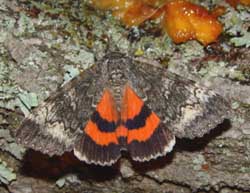
| #8817
briseis;
Briseis Underwing;
60-70mm;
Fws predominantly mottled dark-grey-brown with some lighter areas 1) between postmedial & subterminal lines, 2) at base of am & pm
lines along inner margin, 3) over subreniform spot running diagonally toward costa.
Pm lines do not have greatly elongated and sharly pointed "teeth" near apex.
Hw fringe white & unbroken, inner black band (fairly even) reaches inner margin.
Tim Dyson image.
|

| #8778
Catocala habilis;
wingspan: 55-65mm
Large "M" on thorax,
"pork chop" shaped, light coloured subreniform spot very
dark in constriction at juncture with pml. Pml narrow, dark, distinct, outwardly lined with
narrow suffusion of white scales, followed by broader band of brown
scales, then broader suffusion of white scales up to
very regular dentation of sbtml line.
Significant "bleeding" of yellow-orange-salmon scales into
hw fringes.
Large reniform spot has brown center, faintly edged in black, then
white, then black again.
|

| #8795 Catocala palaeogama
; wingspan: 60-70mm.
Subreniform spot closed, does not approach pm line,
is smaller than in C. habilis.
All forms have characteristic orange, heavily barred fringe to
apex, and irregular bands on hws. Hw basal median
area heavily suffused with dark brown to black scales.
Dark bar in outer half of median area,
paralleling i. m. halfway between
i. m. and light, closed subreniform spot.
Joe Garris photo.
|

| #8795 Catocala palaeogama
form phalanga; wingspan: 60-70mm.
In this form, fw basal area and subterminal
area are very dark against a much lighter background.
Dark bar in the outer half of the
median area, paralleling the inner margin halfway between
the inner margin and the light, closed subreniform spot is especially
evident. Joe Garris image.
|

| ** 8770
Catocala innubens;
Betrothed; 55-72mm.
Forewing is mottled with white, grey and brown, and
subrenifrom spot tends to be lighter in colour, although it is
sometimes obscured by an indistinct blackish bar which runs from
middle of basal/thorax connection to just below much lighter
apex at outer margin.
Jim Vargo image. |

| ** 8770
Catocala innubens form scintillans;
Betrothed; 55-72mm.
In form scintillans most of the basal area (all but lower third) and all of the median area of the forewing is dark reddish brown.
The area outside the pm line is grey.
Vernon A Brou image. |

| ** 8772 Catocala consors WO;
Consort, wingspan: 70mm plus.
Fw with irregular am and pm narrow black lines. Dark patch
outside the reniform and subreniform spots.
The orange-yellow hindwing pm band tends to be narrow and
irregularly zigzagged. Sometimes the band is wider and slightly less
irregular. James K. Adams image.
|

| ** 8857 Catocala ultronia;
Ultronia Underwing, wingspan: 50-63mm.
Fws typically gray-brown, with a distinct and very
dark inner margin and characteristic light brown patch, underscored
by very dark arc, near wingtip.
Underwings can be yellow to orange to salmon.
|

| ** 8857 Catocala ultronia form lucinda;
Ultronia Underwing, wingspan: 50-63mm.
In form lucinda most of the forewing
is bright grey. On all forms there is
extensive orange-salmon colouration on hw ventral surface,
and there is a dark discal lunule.
Full size Joe Garris
photo.
|

| Catocala ultronia,
form nigrescens, the Ultronia Underwing, wingspan: 50-63mm.
In the melanic form nigrescens, the dorsal forewing is very dark.
Even darker subapical arc, basal dash and dash near anal angle are still visible.
Dark basal hairs on hindwing.
Harold J. Vermes slide, used with permission from his son.
|

|
In form celia there is a wide, light grey band separating a dark region along inner margin and
a dark patch near the apex.
The ventral surface of forewings of all forms has a generous suffusion
of orange-salmon scales in the lower half of the median area.
|
 |
** 8779 serena
Serene Underwing. 55-60mm.
Head, collar and abdomen are brown while thorax is grey.
Am and pm lines are thin but very dark and distinct on an
otherwise drab, almost uniformly olive-grey forewing.
Black marginal band of the lower wings is indented at the center,
and relatively narrow, deep yellow median band parallels this
indentation. Basal hairs are brown.
Catocala serena courtesy of
Carroll Rudy.
|
 |
** 8850a herodias gerhardi
Gerhard's Underwing; wingspan: 55-65mm;
Fw grey and brown, no medial
lines. Fw veins somewhat darkened in median
areas with white streaks from pm area to outer
fringe, running parallel to i. m.
Susbspecies has distinctive very light, almost
white, border along fw costa.
|

| ** 8774
muliercula;
Little Wife Underwing, 54-70mm.
The black bands of the hindwings tend to be very wide and there is
considerable dark scaling along the inner margins. Hw
fringe is very dark as is the general reddish-brown ground colour of the forewings.
The forewing apex is preceded along the costa by a lighter,
grey-brown patch.
Steve Walter image.
|

| Catocala coccinata,
the Scarlet Underwing, (wingspan: 57-70mm).
There are usually diffuse basal and anal dashes on an otherwise light
grey, mottled forewing.
The hindwing fringe is white (often with some salmon scaling) and is
heavily checked.
I find the "tooth" just below the pair of very elongated "teeth" is
much reduced and is quite rounded, usually allowing considerable room
for a lighter patch of scales. There is a dark bar across the thorax.
The reniform spot tends be to light, often with a greenish cast to it.
Joe Garris photos.
|

| ** 8801
Catocala ilia; Ilia;
wingspan: 65-82mm.
Several different forms,
most have characteristic white area in and around
reniform spot. Diffuse dark arc running from this
spot to just below apex. Subreniform spot squarish, concave inner and outer edges
and elongated constriction connecting it to pml.
White dots near fw om in character
with the overall "contrasting" appearance.
|

| ** 8801
Catocala ilia; Ilia;
form conspicua
In this form the entire reniform spot is heavily suffused with white scaling on
an otherwise darker ground colour. Hence the form name "conspicua".
Tim Dyson image.
|

| ** 8801
Catocala ilia; Ilia;
form satanas
In this melanic form the entire forewing, including the reniform spot is very dark. Hence the form name "satanas".
The dark basal streak is still evident on this form.
Tim Dyson image.
|

| ** 8801
Catocala ilia; Ilia;
form normani
In this semi-melanic form the entire forewing, excluding the reniform spot, is relatively dark.
The brownish, kidney-shaped center of the reniform spot is outlined in white.
The basal streak and subapical arc are still visible.
Tim Dyson image.
|

| ** 8771 Catocala piatrix ;
Penitent, wingspan: 68-84mm.
Fw: light-colored band/bar extending from light coloured, triangular
subreniform spot along am line to costa. Brown, kidney-shaped reniform spot surrounded in pale grey, outlined in black,
usually with distinct black along wing veins in a dark area outside the reniform spot.
Hw: fringe lightly barred; lighter in color
than deeper orange on rest of wing.
|

| ** 8798 Catocala neogama;
wingspan 70-85mm.
Brown head, thorax, larger size as compared to
C. palaeogama. Neogama tend to be slightly smaller
than subnata, have darker grey brown fws with more
pronounced markings. Examination of hind tibia needed
for id. Neogama's: flattened,
unevenly, sparsely spined; subnata's: cylindrical,
spines dense, uniform in distribution.
Joe Garris photo.
|

| ** 8806 Catocala parta;
Mother Underwing, wingspan: 70-85mm.
The black dashes in the basal, subapical and anal areas help to
identify this species. The hindwings may be yellow to
yellowish-orange but more often are salmon-red. Note the
face-head-like markings on the thorax.
In the hindwing, the first (nearest the apex) black protrusion into
the white fringe is "noticeably" larger than the others.
|

| ** 8857.1
Catocala umbrosa;
mm;
Double brown am line, inward line fainter, filled with off white; reniform spot brown
center outlined in black , off white and black again; subreniform, large, pale brown, closed.
Pm line wit htwo elongated upper teeth, next tooth reduced, next two progressively longer, rounded,
final lobe rounded and shorter. HW with dark scaling/hairs in basal median area along im
|
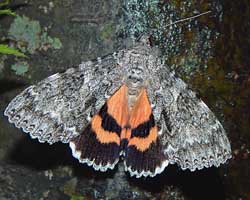
| ** 8805 unijuga;
Once-married; wingspan: 70-90mm: Catocala unijuga has a
fairly wide black inner band (almost reaching inner margin) in
hindwing and very distinctive patterning in forewing. Meskei tend to
have narrower band and dustier (less distinct) looking forewing.
Semirelicta tend to have inner bands that terminate well before
inner margins.
Also note the very white fringe on both the forewings and hindwings.
Carroll Rudy image.
|

| Catocala nebulosa;
75-86mm;
Moths have prominent dark brown upper-half-basal patch that extends
to and ends at antemedial line. Apical area also tends to be
brown, much darker than median area but not as dark as basal patch.
The anal angle also has the darker brown scaling.
The pm line is distinct near costa and inner margin, but becomes
weak between the two. It meets inner margin in relative close
proximity to am line.
Closed subreniform spot is large and connects to the
pm line via a thin line.
|
Catocala nebulosa, Stillwater Township, Sussex County, 2014, Joe Garris.

| ** 8797 Catocala subnata;
Youthful Underwing: 75-90mm.
Fws greyish white with blue-grey and light brown scales,
usually with hws brighter
yellow than those of neogama. Neogama usually
have basal dash; absent in male subnata, but present in females.
Magnification of hind tibia needed for id:
subnata: cylindrical hind tibia;
neogama: compressed or flattened hind tibia.
subnata: ventral surface of tibia densely covered with evenly
distributed spines;
neogama: ventral surface of tibia sparsely covered.
|
Pink Underwings

| Catocala concumbens,
the Sleepy or Pink Underwing, 60-75mm):
This medium sized species is distinctive with thin black am and pm
lines on a forewing light grey with some brown mottling. The
subreniform spot is widely open into the submarginal area. The head
and thoracic collar are brown.
If you haven't identified it by its forewings, the flash of
bright pink bands and pure white, very lightly checked
hindwing fringe will refresh your memory.
Full size Joe Garris photo.
|

| Catocala concumbens,
the Sleepy or Pink Underwing, 60-75mm:
This brown thoracic collar is quite evident in this image as is the
interruption in the pm line by the open subreniform spot.
The white hindwing fringe is only lightly checked
on the wing veins. The vibrant pink bans are
distinct in colour and also in their relatively smooth contour.
Full size Joe Garris photo.
|

| ** 8832 Catocala cara;
Darling; 70-85mm.
Note deep maroon almost purple cast to fws, mixed with
very pale green. Lower half of am & pm lines is barely
visible. There are no distinctive bars or dashes. The two upper
"teeth" on the pm line are thin and long.
The hindwing bands are pink. There is heavy black checking on the
off-white hindwing fringe. The relatively thick black median band of the
hindwing almost reaches the inner margin which is usually heavily
adorned with dark hairs.
Tim Dyson image.
|

| ** Catocala carissima;
wingspan 70-85mm. Distinct light grey brown area at fw apex, preceded just inside pm line by slightly darker patch.
Am and pm lines sharp and dark.
Hw inner black band wide, complete, merges with extensive grey-black scaling along im. Hw fringe cream coloured.
|

|
** 8834 amatrix
Sweetheart Underwing; (wingspan 75-95mm).
Very skittish, frequently hides in caves, under
bridges, under tree bark, etc. by day, resting with head down.
Hw patterning and colouration similar to that of
C. concumbens, but large size (wingspan 75-95mm)
and dark bar running from basal area to just below apex
distinguishes C. amatrix. See large
Catocala amatrix courtesy of
Joan F. Rickert.
|

|
** 8834 amatrix form selecta
Sweetheart Underwing; (wingspan 75-95mm)
Very skittish and frequently hides in caves, under
bridges, under tree bark, etc. by day, resting with head down.
Several forms, including selecta (to the left)
which lacks dark bar on forewing. Hesseli: melanic form;
pallida: very pale form.
|

|
** 8834 amatrix form hesseli
Sweetheart Underwing; (wingspan 75-95mm)
Very skittish and frequently hides in caves, under
bridges, under tree bark, etc. by day, resting with head down.
The melanic form hesseli is very dark and displays dark basal hairs in the hindwing.
|
|
